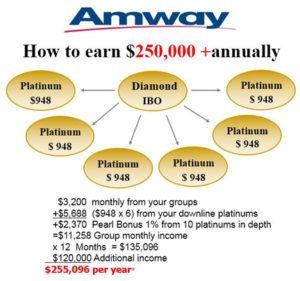Let everybody be a salesman – Amway in China now challenged by WeChat Merchants

Amway succeeded in crowdsourcing without digital technology. When WeChat arrived, it grew way faster and Amway became disrupted.
Amway, whose name came from “American Way”, is a self-acclaimed successful company, where high-quality household products were developed internally, and sold through non-employee sales people, called “Independent Business Owners” (IBOs), in a multi-level marketing model.[i] Celebrating itself as a way to offer low-skilled, often unemployed people a way to financial success, it is also under the accusation of operating a “pyramid scheme”, where existing sales people make money through the expansion of sales network rather than selling to real customers[ii]. After entering China in 1995, Amway survived waves of legal scrutiny on its business model and grew steadily until 2013.[iii] It is now being challenged by its own, digitally more evolved equivalent, the new “IBOs” businesses on WeChat. WeChat, the most popular mobile app in China, allows users to open “shops”, market products through posting images and status, and complete sales via chat and mobile wallet. New brands and new products have come to replace Amway to profit from the ethically questionable business model.
In early 2014, driven by curiosity, I ventured into an Amway regional center in Xinzhuang, on the outer ring of Shanghai, China, to understand first-hand its self-declared success versus the widely criticized “brainwashing” classes. Amway ran “training sessions” frequently for its IBOs, who are not paid salaries, but given “rewards” if they or their recruits book sales. Dressing up their products as highly superior to competitors’, Amway trains the IBOs to personally speak to and convince friends and family to order directly from Amway. The IBOs also try to recruit their “customers” to become IBOs, selling on the potential of financial success of becoming an IBO. Most customers are housewives of rural immigrant families.


Value creation: having learned about Amway’s products, I saw no real value compared to cheaper equivalents in the market, but significant up-selling of benefits. (For example, they demonstrate to potential buyers the coconut scent in their air filters, to indicate the high-quality carbon filter being made from coconut shells. In reality, any original scent would have been destroyed by the carbonizing process, hence the scent could only be artificially added to the carbon.) However, I discovered that the up-selling of benefits were enabled by the TRUST between personal relationships, as well as the lack of scientific knowledge of the buyer. This perceived value is further bolstered by Amway being an American brand, self-acclaimed excellence of its R&D center, and advertisements of Nutrillite products using Olympic gold medalists.
Value capture: Amway products commands high prices, hence high profit. It then distributes some profits to the IBOs, as well as the higher-level IBOs that recruited the former.
Crowd-sourcing platform of numerous IBOs, Amway promises an alternative to formal employment, an apparent easy start, highly enthusiastic and welcoming atmosphere, as well as the long-term bait of financial success.
Amway saw its revenue in China peak in 2013, then started unstoppable declines since 2014. While no public analyses has connected the decline to the rise of WeChat merchants, I personally tend to believe a strong connection exist between these trends.
Launched in 2011 by Tencent in China, the mobile application WeChat soon became the most popular chat and social network platform in China. As it launched payment function in 2013[iv], WeChat users can operate virtual stores by posting merchandise images, and sell to connected “friends”. This process shifted the offline sales process of Amway to an efficient online process. Products and brands also cater to the millennial WeChat users, ranging from facial masks, fashion items, health supplements, sex toys and “medicines”, as well as overseas branded products. Many products are sold under new brands, said to have superb qualities, and have potentially very high margins for the sellers.[v]


The WeChat platform offers similar reward systems to the merchants, while allowing users to reach their networks more efficiently, without the overhead cost of physical visits. This lowers the barrier for the value of goods – one could profit by selling a $2 pair of socks, rather than a $200 Nutrillite package. WeChat platform compete with Amway by attracting merchants from the same crowd, as well as appealing to the same gullible buyers.
My takeaway: crowdsourcing happened without digital technology, as in the case of Amway. When WeChat arrived, it grew way faster.
[i] http://globalnews.amway.com/ourstory
[ii] https://www.nytimes.com/2015/09/15/opinion/joe-nocera-the-pyramid-scheme-problem.html?_r=0
[iii] http://www.crainsdetroit.com/article/20170208/NEWS/170209835/amway-sales-fall-for-3rd-straight-year
[iv] http://tech.sina.com.cn/zl/post/detail/i/2016-08-12/pid_8508235.htm
[v] http://www.113dh.com/2607.html



Great post Hao!!! I never view the business model of Amway as crowd sourcing sales force but you are exactly right. More interestingly, it was truly insightful to know about the similar product line offered by WeChat. It is no doubt that WeChat can leverage its digital platform and network, realizing low inventory and logistics cost. I personally do not like this kind of “Ponzi scheme” as I believe the traditional model put an inventory risk to the low-end sales force of the pyramid. Having said that, this WeChat model seems different. It seems it enables to avoid putting the inventory risk to the sales force and the model only uses the individual sales force as the market channel with commission. It is different from the ponzi scheme and we may even see it as a way of creating business opportunity for individuals. I never used WeChat but more I hear about the product, the more I am intrigued. I wish the product launches in Japan soon.
Hi Hao! Great post. I’d love to hear more about the practices of the most successful merchants on WeChat? Are they able to achieve the same level of success as AmWay merchants? Couldn’t an AmWay merchant also set up a WeChat shop for their AmWay products, and in this way, isn’t WeChat a complementer to AmWay and not a competitor?